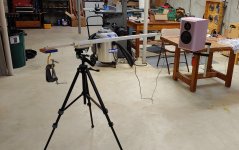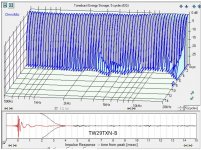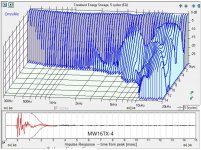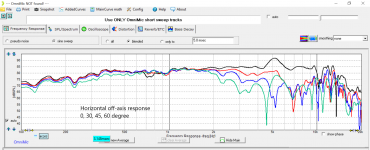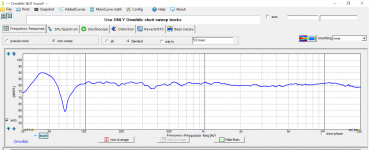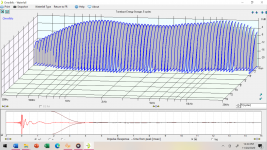Harwood Acoustics | hifisound.de | Your online hifi specialist
That was quick! "HARWOOD" in Europe...
That was quick! "HARWOOD" in Europe...
I believe I have refined my test setup to the point where it can measure an accurate waterfall response. I needed to build a more rigid baffle than my simple 24 x 24-inch foam board. So I built a prototype box from foam board, reinforced, and open back.
The Omnimic software has the capability of producing a “Tone-burst Energy Storage” plot. I am sure many people are familiar with the TES plot, but for those unfamiliar, I will give a short explanation.
The TES plot is very similar to a waterfall plot, but with two differences.
(1) The input function for the TES is a 5-cycle sinewave of gradually increasing then decreasing energy, whereas in the traditional waterfall plot, the input is an impulse. The plot will show expected response in grey, and any acoustic energy beyond the tone-burst signal will be displayed as light-blue. The expected (grey) response ends at 3 cycles, so anything beyond 3 cycles is an unexpected response (blue).
(2) The y-axis of the traditional waterfall plot is time, usually in milliseconds. The y-axis of the TES plot is cycles. This is an important distinction, and one reason why I like the TES plot. On a traditional waterfall plot, if we observe delayed energy at both 2 kHz and 10 kHz which falls down to -30 dB after 3 ms, both the 2 khz and 10 kHz resonances would look similar even though 3 ms represents 6 cycles of 2 kHz and 30 cycles at 10 kHz. This same response on a TES plot would be displayed along the y-axis as 6 cycles at 2 kHz and 30 cycles at 10 kHz.
With that explanation, I will get on to the data. First, I have a photo of my test setup. Next is the TES plots of the two drivers. These plots have been normalized to a flat frequency response.
Satori TW29TXN-B
The TES plot of the TW29TXN-B shows some low level “delayed energy” between 1.5 kHz and 8 kHz, at a level of -25 dB. This same signature is present on every driver I have ever tested, so I am convinced it is inherent to my test setup, probably a reflection near my microphone. Therefore, I am assuming that my noise threshold for this test is -25 dB between 1.5 kHz and 8 kHz, and anything below that is ambient noise. On the other hand, the delayed energy above 16 kHz is very likely a real response. It is a very well damped resonance, starting out at -20 dB and quickly falling to -30 dB after about 3 cycles.
Satori MW16TX-4
The TES plot of the MW16TX driver again shows my ambient noise problem from 1.5 k to 3.5 k below -25 dB, so this response should be ignored. Beginning around 4 kHz, we see the start of some resonant behavior which seems centered at around 5 kHz. The resonance starts off at about -8 dB and quickly drops down to below -30 dB after just 8 cycles. I consider this a very well controlled resonance, quite different than a metal cone driver. Between 10 - 20 kHz, there is another wide band resonance which is less well damped. Any resonance in this region is insignificant because it is at least well outside the operating band of the driver. Even this resonance is damped enough that the frequency response is quite reasonably flat in this range.
I look forward to HiFiCompass completing his assessment of the MW16TX... I consider his measurements to set the standard, so we shall see how close my measurements come.
J.
The Omnimic software has the capability of producing a “Tone-burst Energy Storage” plot. I am sure many people are familiar with the TES plot, but for those unfamiliar, I will give a short explanation.
The TES plot is very similar to a waterfall plot, but with two differences.
(1) The input function for the TES is a 5-cycle sinewave of gradually increasing then decreasing energy, whereas in the traditional waterfall plot, the input is an impulse. The plot will show expected response in grey, and any acoustic energy beyond the tone-burst signal will be displayed as light-blue. The expected (grey) response ends at 3 cycles, so anything beyond 3 cycles is an unexpected response (blue).
(2) The y-axis of the traditional waterfall plot is time, usually in milliseconds. The y-axis of the TES plot is cycles. This is an important distinction, and one reason why I like the TES plot. On a traditional waterfall plot, if we observe delayed energy at both 2 kHz and 10 kHz which falls down to -30 dB after 3 ms, both the 2 khz and 10 kHz resonances would look similar even though 3 ms represents 6 cycles of 2 kHz and 30 cycles at 10 kHz. This same response on a TES plot would be displayed along the y-axis as 6 cycles at 2 kHz and 30 cycles at 10 kHz.
With that explanation, I will get on to the data. First, I have a photo of my test setup. Next is the TES plots of the two drivers. These plots have been normalized to a flat frequency response.
Satori TW29TXN-B
The TES plot of the TW29TXN-B shows some low level “delayed energy” between 1.5 kHz and 8 kHz, at a level of -25 dB. This same signature is present on every driver I have ever tested, so I am convinced it is inherent to my test setup, probably a reflection near my microphone. Therefore, I am assuming that my noise threshold for this test is -25 dB between 1.5 kHz and 8 kHz, and anything below that is ambient noise. On the other hand, the delayed energy above 16 kHz is very likely a real response. It is a very well damped resonance, starting out at -20 dB and quickly falling to -30 dB after about 3 cycles.
Satori MW16TX-4
The TES plot of the MW16TX driver again shows my ambient noise problem from 1.5 k to 3.5 k below -25 dB, so this response should be ignored. Beginning around 4 kHz, we see the start of some resonant behavior which seems centered at around 5 kHz. The resonance starts off at about -8 dB and quickly drops down to below -30 dB after just 8 cycles. I consider this a very well controlled resonance, quite different than a metal cone driver. Between 10 - 20 kHz, there is another wide band resonance which is less well damped. Any resonance in this region is insignificant because it is at least well outside the operating band of the driver. Even this resonance is damped enough that the frequency response is quite reasonably flat in this range.
I look forward to HiFiCompass completing his assessment of the MW16TX... I consider his measurements to set the standard, so we shall see how close my measurements come.
J.
Attachments
Complete set of measurements for TW29TXN-B and MW16TX-4
Unfortunately all the measurements I made for these two drivers are spread over a number of posts... Here is an index for easy reference
Impedance and ZMA files for TW29TXN-B (post 542)
https://www.diyaudio.com/forums/multi-way/343831-sb-acoustics-textreme-55.html#post6395143
Frequency response and FRD files for TW29TXN-B (post 546)
https://www.diyaudio.com/forums/multi-way/343831-sb-acoustics-textreme-55.html#post6395452
Impedance and ZMA files for MW16TX-4 (post 543)
https://www.diyaudio.com/forums/multi-way/343831-sb-acoustics-textreme-55.html#post6395154
Frequency response and FRD files for MW16TX-4 (post 549)
https://www.diyaudio.com/forums/multi-way/343831-sb-acoustics-textreme-55.html#post6395602
Tone-burst Energy Storage plots for both drivers (post 606 above)
Unfortunately all the measurements I made for these two drivers are spread over a number of posts... Here is an index for easy reference
Impedance and ZMA files for TW29TXN-B (post 542)
https://www.diyaudio.com/forums/multi-way/343831-sb-acoustics-textreme-55.html#post6395143
Frequency response and FRD files for TW29TXN-B (post 546)
https://www.diyaudio.com/forums/multi-way/343831-sb-acoustics-textreme-55.html#post6395452
Impedance and ZMA files for MW16TX-4 (post 543)
https://www.diyaudio.com/forums/multi-way/343831-sb-acoustics-textreme-55.html#post6395154
Frequency response and FRD files for MW16TX-4 (post 549)
https://www.diyaudio.com/forums/multi-way/343831-sb-acoustics-textreme-55.html#post6395602
Tone-burst Energy Storage plots for both drivers (post 606 above)
Could be cool to see if the midrange would perform more even - no bump off-axis at around 2,6KHz, if the baffle was cut narrow around the driver like most of the designs from Heissmann.
Thank you for your thoughts...
I have not decided what the form of my enclosure would be. The foamboard boxes are first generation prototypes... I would like to do a highly profiled baffle such as Avalon, Revel Salon, Heissmann as you mentioned, or Magico... I need to carefully assess my craftsmanship skills. I am certain I could build this kind of baffle, but could I also make it beautiful?
Fixed the links for you (or really, for other people). I think the problem has to do with when another viewer has the "# of posts per page" setting at a different number than yours.Unfortunately all the measurements I made for these two drivers are spread over a number of posts... Here is an index for easy reference
Impedance and ZMA files for TW29TXN-B (post 542)
SB Acoustics Textreme.
Frequency response and FRD files for TW29TXN-B (post 546)
SB Acoustics Textreme.
Impedance and ZMA files for MW16TX-4 (post 543)
SB Acoustics Textreme.
Frequency response and FRD files for MW16TX-4 (post 549)
SB Acoustics Textreme.
Tone-burst Energy Storage plots for both drivers (post 606 above)
Ok thanks hifijim for the measurements, but have you already test the sound of the textreme ?
Great new for me, no dip of THD (and dig on SPL curve) at 1250hz like the other Satori with papyrus cone.
Hificompass was received seven SBA speaker for measurements:
Silk membrane tweeters SB21RDCN-C0004 и SB21SDCN-C000-4
Beryllium dome tweeter Satori TW29BNWG-4
Carbon-fiber dome (Textreme) tweeter Satori TW29TXN-4
2.5" silk dome midrange Satori MD60N-6
6" carbon-fiber cone (Textreme) midwoofer Satori MW16TX-4
7" carbon-fiber cone (Textreme) midwoofer Satori MW19TX-4
The magnificent seven from SB Acoustics! | HiFiCompass
Great new for me, no dip of THD (and dig on SPL curve) at 1250hz like the other Satori with papyrus cone.
Hificompass was received seven SBA speaker for measurements:
Silk membrane tweeters SB21RDCN-C0004 и SB21SDCN-C000-4
Beryllium dome tweeter Satori TW29BNWG-4
Carbon-fiber dome (Textreme) tweeter Satori TW29TXN-4
2.5" silk dome midrange Satori MD60N-6
6" carbon-fiber cone (Textreme) midwoofer Satori MW16TX-4
7" carbon-fiber cone (Textreme) midwoofer Satori MW19TX-4
The magnificent seven from SB Acoustics! | HiFiCompass
Hificompass was received seven SBA speaker for measurements:
Silk membrane tweeters SB21RDCN-C0004 и SB21SDCN-C000-4
Beryllium dome tweeter Satori TW29BNWG-4
Carbon-fiber dome (Textreme) tweeter Satori TW29TXN-4
2.5" silk dome midrange Satori MD60N-6
6" carbon-fiber cone (Textreme) midwoofer Satori MW16TX-4
7" carbon-fiber cone (Textreme) midwoofer Satori MW19TX-4
I'm very interested in the Satori MW19TX-4. It's the largest of the bunch, and seems to have a lot going for it based on the FR and IMP curves and other data from SB. I got a bit of sticker shock when I got preliminary pricing from my dealer, and since this is one of the drivers that HiFiCompass will test I will probably wait to see if any problems are revealed before I decide whether to dump a bunch of cash into a pair of them.
When I had the MW16TX mounted in the 24x24-inch foam board open baffle, I did listen to it. Full range, no eq or filter, just the driver. It sounded good, clean, low distortion, lots of detail.
However, when it comes to high performance drivers, I have never believed that you can tell much by listening to them full range... They all sound pretty good, and they all will sound different once they are properly integrated with a tweeter and perhaps woofer.
I am working on a preliminary digital filter for these drivers as mounted in the foam board box. I will post more when I have some results.
And thanks 454Casull for correcting my links.
However, when it comes to high performance drivers, I have never believed that you can tell much by listening to them full range... They all sound pretty good, and they all will sound different once they are properly integrated with a tweeter and perhaps woofer.
I am working on a preliminary digital filter for these drivers as mounted in the foam board box. I will post more when I have some results.
And thanks 454Casull for correcting my links.
Aurum Cantus AST2560 Aero Striction Tweeter
Oh DEAR ME!!! I have wanted to try these since they came out; now on sale!!!
I just sold my G3Si Ribbons; these AMTs from Aurum Cantus normally sell for the same price as the ribbons...
I think I'll drop my price on my CAC 17 on the swap shop now; need quick cash so I can get these AC AMT's on sale!!!
Too bad Aurum Cantus AST25120 tweeter never seems to go on sale!
Aurum Cantus AST25120 Aero Striction Tweeter 8 Ohm
...I got a bit of sticker shock...
uh yeah... they are definitely pricey. I am hoping that just as the original papyrus satori drivers competed with the ScanSpeak Revelator at a lower cost, perhaps the textreme satori will compete with the ScanSpeak Illuminator and Elipticor, Seas Excel, and Accuton at a lower cost.
So far, based on my measurements, I am optimistic.
When I had the MW16TX mounted in the 24x24-inch foam board open baffle, I did listen to it. Full range, no eq or filter, just the driver. It sounded good, clean, low distortion, lots of detail.
However, when it comes to high performance drivers, I have never believed that you can tell much by listening to them full range... They all sound pretty good, and they all will sound different once they are properly integrated with a tweeter and perhaps woofer.
I am working on a preliminary digital filter for these drivers as mounted in the foam board box. I will post more when I have some results.
And thanks 454Casull for correcting my links.
Ok thanks, have you compared to other Satori with papyrus cone ?
No I have not. I have no experience with the papyrus satori.
My current system uses SB17CAC35 and SB26CDC ceramic-aluminum drivers. Some casual listening seemed to show that the Satori textreme drivers were superior in several ways.... but this was just a first listen, and it could be my mind playing tricks with me. Only after I fully optimize the filters on the new drivers and do some critical, skeptical listening would I feel comfortable making statements about the new Satori driver sound quality.
My current system uses SB17CAC35 and SB26CDC ceramic-aluminum drivers. Some casual listening seemed to show that the Satori textreme drivers were superior in several ways.... but this was just a first listen, and it could be my mind playing tricks with me. Only after I fully optimize the filters on the new drivers and do some critical, skeptical listening would I feel comfortable making statements about the new Satori driver sound quality.
I have created a preliminary filter for these new textreme drivers.
These new textreme drivers will eventually replace the current satellites of my system. I built the foam-board enclosure as a prototype to experiment with. I built just one, so all measurements and listening is in mono.
My current system is an active 3 way with each side consisting of a 12 inch SB34NRX75-6 (sealed), 6 inch SB17CAC35-4, 1 inch tweeter SB26CDC-C00. I use a Hypex Fusion FA253 3-way amp. The big woofers are in their own cabinet, and the 6 inch and tweeter are in a stand mounted satellite. The amp is located in the stand. Crossovers are at 200 Hz BW3 and 2 kHz LR4. The Hypex amps have DSP capability, so the filters, EQ, and delay are all handled digitally.
The drivers required a very minimal amount of EQ within their pass band. The mid driver needed 8 dB of baffle step compensation, and a notch filter at 5 kHz to control the cone resonance. The tweeter needed a slight boost at 3.2k. As a starting point I am using BW3 at 200 Hz and LR4 at 2 kHz. There is 680 mm of delay between the woofer and the mid because the satellite is about 2 feet in front of the woofer cabinet. There is an additional 26 mm of delay between the mid and tweeter. The mid-tweeter delay was optimized by inverting the tweeter polarity and adjusting the delay to get the maximum null.
All of the following measurements were measured at 24 inches from the satellite, on an axis mid-way between the tweeter and mid driver. The first plot is the on-axis FR. The time window was 4.7 ms. I must admit that getting a good flat response was much easier with these drivers than it was with the SB ceramic drivers, mostly due to very forgiving nature of the Satori MW16TX.
The next plot is the Tone-Burst Energy Storage plot for the whole system. I am pleased with this performance. I posted this to show that the MW16TX resonances at 5k-up are easilly handled with proper filtering.
Everyone seems curious about how these new drivers sound. Listening in mono it sounded really good. It takes several minutes to switch all the wiring to go from one speaker to the other, and then load the other DSP file into the amps. This is not an ideal way to compare two speakers. I could not do a fair A/B comparison.
These textreme Satori drivers will need a real cabinet to reach their full potential. The foamboard cabinets are not resonance free and at some frequencies there is some wall vibration. In addition, the driver recesses were crudely cut with a utility knife and it was hard to get the exact depth correct. The tweeter is recessed too deeply and the mid driver is not recessed enough. For a speaker stand I used a stack of boxes. All in all, not ideal.
I listened as critically and as skeptically as I could, but in the end, I believe I could hear a more natural, relaxed, and realistic sound compared to the SB17CAC/SB26CDC satellite. The ceramic drivers have always had excellent dynamic contrast and are very detailed and revealing. The textreme drivers are equal to the ceramic drivers in terms of detail, resolution, and dynamics. But the textremes just seemed a little more natural. It is difficult to pinpoint exactly what I am hearing that is different, but I like it. I must stress that this is a highly subjective opinion at this point. I will be able to do a much better assessment once I assemble a pair of real cabinets.
Overall I am highly impressed with these drivers.
These new textreme drivers will eventually replace the current satellites of my system. I built the foam-board enclosure as a prototype to experiment with. I built just one, so all measurements and listening is in mono.
My current system is an active 3 way with each side consisting of a 12 inch SB34NRX75-6 (sealed), 6 inch SB17CAC35-4, 1 inch tweeter SB26CDC-C00. I use a Hypex Fusion FA253 3-way amp. The big woofers are in their own cabinet, and the 6 inch and tweeter are in a stand mounted satellite. The amp is located in the stand. Crossovers are at 200 Hz BW3 and 2 kHz LR4. The Hypex amps have DSP capability, so the filters, EQ, and delay are all handled digitally.
The drivers required a very minimal amount of EQ within their pass band. The mid driver needed 8 dB of baffle step compensation, and a notch filter at 5 kHz to control the cone resonance. The tweeter needed a slight boost at 3.2k. As a starting point I am using BW3 at 200 Hz and LR4 at 2 kHz. There is 680 mm of delay between the woofer and the mid because the satellite is about 2 feet in front of the woofer cabinet. There is an additional 26 mm of delay between the mid and tweeter. The mid-tweeter delay was optimized by inverting the tweeter polarity and adjusting the delay to get the maximum null.
All of the following measurements were measured at 24 inches from the satellite, on an axis mid-way between the tweeter and mid driver. The first plot is the on-axis FR. The time window was 4.7 ms. I must admit that getting a good flat response was much easier with these drivers than it was with the SB ceramic drivers, mostly due to very forgiving nature of the Satori MW16TX.
The next plot is the Tone-Burst Energy Storage plot for the whole system. I am pleased with this performance. I posted this to show that the MW16TX resonances at 5k-up are easilly handled with proper filtering.
Everyone seems curious about how these new drivers sound. Listening in mono it sounded really good. It takes several minutes to switch all the wiring to go from one speaker to the other, and then load the other DSP file into the amps. This is not an ideal way to compare two speakers. I could not do a fair A/B comparison.
These textreme Satori drivers will need a real cabinet to reach their full potential. The foamboard cabinets are not resonance free and at some frequencies there is some wall vibration. In addition, the driver recesses were crudely cut with a utility knife and it was hard to get the exact depth correct. The tweeter is recessed too deeply and the mid driver is not recessed enough. For a speaker stand I used a stack of boxes. All in all, not ideal.
I listened as critically and as skeptically as I could, but in the end, I believe I could hear a more natural, relaxed, and realistic sound compared to the SB17CAC/SB26CDC satellite. The ceramic drivers have always had excellent dynamic contrast and are very detailed and revealing. The textreme drivers are equal to the ceramic drivers in terms of detail, resolution, and dynamics. But the textremes just seemed a little more natural. It is difficult to pinpoint exactly what I am hearing that is different, but I like it. I must stress that this is a highly subjective opinion at this point. I will be able to do a much better assessment once I assemble a pair of real cabinets.
Overall I am highly impressed with these drivers.
Attachments
- Home
- Loudspeakers
- Multi-Way
- SB Acoustics Textreme
